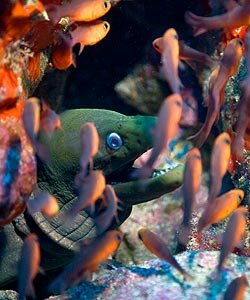Most deep sea fisheries are unsustainable and should be closed, a new report says.
The call comes after a 25-year-long marine study revealed that commercial fishing in the north-east Atlantic could be damaging species at much greater depths than previously believed.

Moray eel - the study found numbers of one species of eel were down by half
Numbers of deep-water species living a kilometre below the reach of trawlers are apparently being affected by fishing practices, the new study found.
Although scientists have known that commercial fishing does affect deep-water fish populations they have now discovered it is occuring at much greater depths.
Populations of north-east Atlantic commercial deep-water fish such as black scabbardfish, orange roughy and roundnose grenadier have dwindled since deep-water fishing started in the area in the late 1980s but a quota system wasn’t introduced until 2003.
Dr David Bailey of the University of Glasgow, who led the study, published in the journal Proceedings of the Royal Society B, said:
“Commercial fishing may have wider effects than anyone previously thought, affecting fish which we assumed were safely beyond the range of fishing boats. We were extremely surprised by this result and believe that it has important implications for how we manage the oceans.”
Deep-water fish living off the west coast of Ireland were monitored by Natural Environment Research Council-owned ships from 1977 until 1989 before any fishery was operating in the region.
Researchers checked the same area again from 1997 until 2002 using exactly the same methods and the results were then compared as part of an EU-led project to study deep-sea species.Most deep-water trawlers take fish down to 1600 metres but the survey revealed that deep-sea fish numbers down to 2500 metres - a kilometre below the deepest reach of fishing trawlers - were lower in the later period.
Both target and non-target species were affected and in much deeper parts of the ocean and in one species of eel, numbers had dropped by half.
Professor Monty Priede of the University of Aberdeen’s Oceanlab, said: “The deep-seas fishery targets relatively few species, such as roundnose grenadier and orange roughy and unwanted species are discarded.
“These can make up around 50 per cent of the catch and because of the extreme change in pressure and temperature when they’re brought to the surface, none of these will survive. This explains why the study has shown a decrease in abundance of target and non-target species.
A member of the study team, Dr John Gordon of the Scottish Association for Marine Science, said: “Each deep-water species has a defined depth range and very often the juveniles live at depths shallower than the adults.
“Removal of fish by commercial trawling down to 1600 metres is likely to affect populations in deeper waters.”
“The general consensus is that deep-water fisheries are unsustainable and most if not all should be closed,” he added.
The report’s authors said fishery managers needed to take into account adverse effects on the ecosystem and not just the abundance of targeted stocks and suggested trawling may need to be restricted to a much greater degree.
The study, which involved researchers from the University of Glasgow, the British Antarctic Survey, the Scottish Association for Marine Science, Highland Statistics and the University of Aberdeen’s Oceanlab, concluded that current plans for Marine Protected Areas (MPA) in the north-east Atlantic might not be enough to protect the deep-water species.
“Marine Protected Areas need to be much bigger than the existing coral-protecting MPAs. They are not very effective for mobile fish species unless the fishing effort itself is reduced,” said Professor Priede.
![]()



0 Responses to “Deep sea fish suffer far greater damage than was first thought”
Leave a Reply